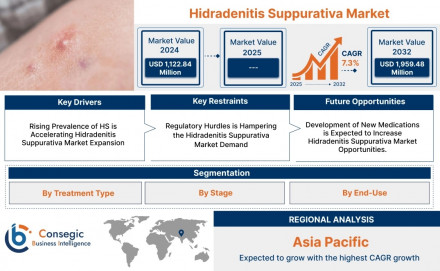Hidradenitis Suppurativa Market: Key Players and Market Dynamics (2025-2032)

Hidradenitis Suppurativa Market Size:
Hidradenitis Suppurativa Market size is growing with a CAGR of 7.3% during the forecast period (2025-2032), and the market is projected to be valued at USD 1,959.48 Million by 2032 from USD 1,122.84 Million in 2024.
Hidradenitis Suppurativa Market Overview:
The global hidradenitis suppurativa market is experiencing steady growth, driven by the increasing prevalence of the disease and rising demand for targeted biologic therapies. The market includes a range of treatment options, from antibiotics and corticosteroids to advanced biologics like TNF inhibitors. Despite being underdiagnosed in many parts of the world, awareness campaigns and educational initiatives are bringing the disease into greater clinical focus. The HS market is segmented into prescription drugs, over-the-counter products, and surgical interventions, with biologics expected to dominate due to their efficacy in moderate-to-severe cases.
Hidradenitis Suppurativa Market Includes Drivers, Restraints & Opportunities
Key Drivers:
- Rising Prevalence: The increasing number of diagnosed HS cases worldwide is a primary growth driver. HS affects around 1–4% of the global population.
- Biologic Drug Development: The emergence of biologics such as adalimumab (Humira) has significantly changed treatment approaches, offering more effective and targeted options.
- Increasing Awareness: Public health campaigns and educational initiatives by healthcare providers and advocacy groups have improved disease recognition and diagnosis.
- Government and NGO Initiatives: Support for rare and chronic disease treatment has led to funding for research and patient assistance programs.
- R&D Investments: Pharmaceutical companies are actively investing in clinical trials for new therapies, including JAK inhibitors and IL-17 blockers.
Key Restraints:
- Limited Treatment Options: Despite the introduction of biologics, treatment efficacy varies, and no cure currently exists.
- High Cost of Biologics: Biologic drugs are expensive, limiting access for patients in low- and middle-income countries.
- Diagnostic Challenges: HS is often misdiagnosed or diagnosed late, delaying treatment and affecting patient outcomes.
- Side Effects of Existing Treatments: Long-term use of immunosuppressants or antibiotics can lead to adverse effects, deterring prolonged treatment.
- Lack of Clinical Guidelines: There is still limited standardization in treatment protocols across different countries.
Future Opportunities:
- Emerging Therapies: Pipeline drugs, including IL-23, IL-17, and JAK inhibitors, offer new hope for improved efficacy and safety profiles.
- Personalized Medicine: Advancements in genomics and biomarkers could allow for tailored treatment strategies based on patient-specific characteristics.
- Digital Health Platforms: Telemedicine and mobile health apps are emerging as tools for early diagnosis, monitoring, and management of chronic skin diseases.
- Expansion in Emerging Markets: Untapped markets in Asia-Pacific, Latin America, and Africa provide substantial growth potential due to increasing healthcare access.
- Collaborative Research: Partnerships between biotech firms, academia, and pharmaceutical companies are accelerating innovation.
Hidradenitis Suppurativa Market Competitive Landscape Analysis (Key Players)
- UCB Biotechnology (Belgium)
- AbbVie (U.S.)
- Priovant Therapeutics (U.S.)
- UNION Therapeutics (Denmark)
- MoonLake Immunotherapeutics (Switzerland)
- Novartis (Switzerland)
- Incyte (U.S.)
- Eli Lilly and Company (U.S.)
- Aclaris Therapeutics (U.S.)
- Boehringer Ingelheim (Germany)
Hidradenitis Suppurativa Market Industry Segmentation:
By Treatment Type
- Medications
- Antibiotics
- Biologics
- Corticosteroids
- Others
- Surgical
By Stage
- Hurley Stage I
- Hurley Stage II
- Hurley Stage III
By End-Use
- Hospital
- Dermatology Clinics
- Others
By Region
- Asia-Pacific
- Europe
- North America
- Latin America
- Middle East & Africa
Regional Analysis of the Hidradenitis Suppurativa Market:
North America:
- Dominates the global HS market due to high awareness, robust healthcare infrastructure, and availability of biologic therapies.
- U.S. accounts for the largest share owing to the early FDA approval of Humira for HS.
Europe:
- Strong market growth with countries like Germany, the UK, and France leading in terms of clinical research and biologic drug availability.
- Favorable reimbursement policies in some regions contribute to market expansion.
Asia-Pacific:
- Emerging market with growing awareness and healthcare access.
- Japan, South Korea, and China are key players in terms of research and patient outreach.
Latin America:
- Moderate growth expected due to improving healthcare systems and increasing diagnosis rates.
- Brazil and Mexico hold the highest potential.
Middle East and Africa:
- Currently underpenetrated but showing signs of improvement with awareness campaigns and foreign pharmaceutical investment.
Hidradenitis Suppurativa Market Recent Developments:
- FDA Approvals & Pipeline Advancements (2023–2025): Several companies have entered phase II/III trials for novel biologics and small molecules such as IL-17 and JAK inhibitors.
- New Treatment Guidelines: Updated recommendations by dermatological associations are incorporating newer treatment protocols and biologics.
- Collaborations & Mergers: Strategic alliances among biotech companies have accelerated R&D in dermatology.
- Digital Monitoring Tools: Implementation of AI-based diagnostic tools and teledermatology platforms has facilitated early detection and monitoring.
- Patient Support Programs: Pharma companies are investing in direct-to-patient education and subsidized treatment programs to improve compliance.
Contact us:
Consegic Business intelligence Pvt Ltd.
Contact no: (US) (505) 715-4344
Email: sales@consegicbusinessintelligence.com

